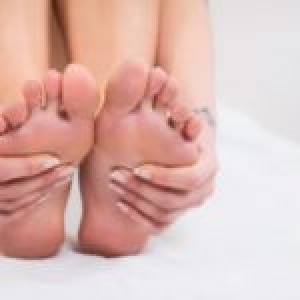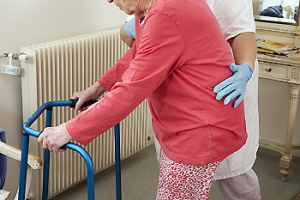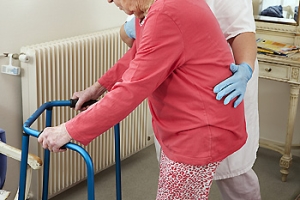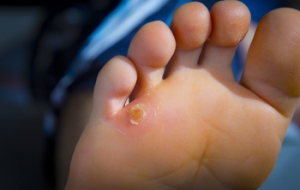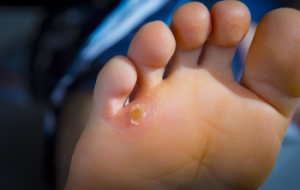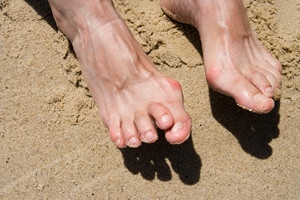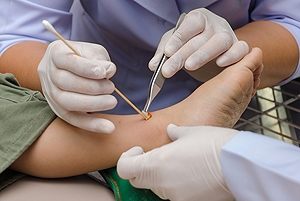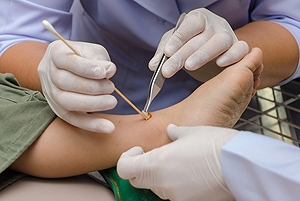Items filtered by date: September 2020
Understanding Corns and Calluses
Corns and calluses can be best explained as hardened tissue on the skin, formed when the skin is subject to repeated pressure or friction. The balls of our feet are most susceptible to developing corns and calluses, however they can form anywhere. A particular well-known cause of corns and calluses are ill-fitting shoes. Suggested methods for preventing corns and calluses are to wear padding or even orthotics in your shoes. Calluses can also be removed with a surgical procedure by your podiatrist. If you are bothered by corns or calluses, consult with a podiatrist to determine if surgical intervention is necessary.
If you have any concerns regarding your feet and ankles, contact Dr. Kenneth Donovan from Advanced Care Foot and Ankle. Our doctor will treat your foot and ankle needs.
Corns: What are they? And how do you get rid of them?
Corns can be described as areas of the skin that have thickened to the point of becoming painful or irritating. They are often layers and layers of the skin that have become dry and rough, and are normally smaller than calluses.
Ways to Prevent Corns
There are many ways to get rid of painful corns such as wearing:
– Well-fitting socks
– Comfortable shoes that are not tight around your foot
– Shoes that offer support
Treating Corns
Treatment of corns involves removing the dead skin that has built up in the specific area of the foot. Salicylic acid can help in getting rid of these corns because it dissolves keratin, which is the protein that makes up a good majority of corns. Podiatrists recommend that people with diabetes not use salicylic acid but should consult with their podiatrist regarding the treatment of corns.
If you have any questions, please feel free to contact one of our offices located in New Jersey. We offer the newest diagnostic tools and technologies to treat your foot and ankle needs.
Strategies That Can Help Prevent Falling
Fear of completing daily activities may follow a fall for elderly people. Falling can lead to foot injuries, including broken toe and foot bones. This can lead to limited independence, and may result in limited physical activity. Research has indicated that many falls can be prevented by implementing safety methods. These can include removing worn rugs from the living environment, improving lighting in the house, and having routine physical examinations, which can be helpful in monitoring existing medication and acquiring updated eyeglass prescriptions. It is beneficial to install grab bars in the bath and toilet areas, in addition to having railings on both sides of the steps. Frequently exercising and performing simple stretches can add strength to the body, which may help to prevent falling. Please confer with a podiatrist who can answer any questions you may have about how falling can affect the feet, and about how to prevent injuries
Preventing falls among the elderly is very important. If you are older and have fallen or fear that you are prone to falling, consult with Dr. Kenneth Donovan from Advanced Care Foot and Ankle. Our doctor will assess your condition and provide you with quality advice and care.
Every 11 seconds, an elderly American is being treated in an emergency room for a fall related injury. Falls are the leading cause of head and hip injuries for those 65 and older. Due to decreases in strength, balance, senses, and lack of awareness, elderly persons are very susceptible to falling. Thankfully, there are a number of things older persons can do to prevent falls.
How to Prevent Falls
Some effective methods that older persons can do to prevent falls include:
- Enrolling in strength and balance exercise program to increase balance and strength
- Periodically having your sight and hearing checked
- Discuss any medications you have with a doctor to see if it increases the risk of falling
- Clearing the house of falling hazards and installing devices like grab bars and railings
- Utilizing a walker or cane
- Wearing shoes that provide good support and cushioning
- Talking to family members about falling and increasing awareness
Falling can be a traumatic and embarrassing experience for elderly persons; this can make them less willing to leave the house, and less willing to talk to someone about their fears of falling. Doing such things, however, will increase the likelihood of tripping or losing one’s balance. Knowing the causes of falling and how to prevent them is the best way to mitigate the risk of serious injury.
If you have any questions, please feel free to contact one of our offices located in Warren, Livingston, and Toms River, NJ . We offer the newest diagnostic and treatment technologies for all your foot care needs.
Strategies That Can Help Prevent Falling
 Fear of completing daily activities may follow a fall for elderly people. Falling can lead to foot injuries, including broken toe and foot bones. This can lead to limited independence, and may result in limited physical activity. Research has indicated that many falls can be prevented by implementing safety methods. These can include removing worn rugs from the living environment, improving lighting in the house, and having routine physical examinations, which can be helpful in monitoring existing medication and acquiring updated eyeglass prescriptions. It is beneficial to install grab bars in the bath and toilet areas, in addition to having railings on both sides of the steps. Frequently exercising and performing simple stretches can add strength to the body, which may help to prevent falling. Please confer with a podiatrist who can answer any questions you may have about how falling can affect the feet, and about how to prevent injuries
Fear of completing daily activities may follow a fall for elderly people. Falling can lead to foot injuries, including broken toe and foot bones. This can lead to limited independence, and may result in limited physical activity. Research has indicated that many falls can be prevented by implementing safety methods. These can include removing worn rugs from the living environment, improving lighting in the house, and having routine physical examinations, which can be helpful in monitoring existing medication and acquiring updated eyeglass prescriptions. It is beneficial to install grab bars in the bath and toilet areas, in addition to having railings on both sides of the steps. Frequently exercising and performing simple stretches can add strength to the body, which may help to prevent falling. Please confer with a podiatrist who can answer any questions you may have about how falling can affect the feet, and about how to prevent injuries
Preventing falls among the elderly is very important. If you are older and have fallen or fear that you are prone to falling, consult with Dr. Kenneth Donovan from Advanced Care Foot and Ankle. Our doctor will assess your condition and provide you with quality advice and care.
Every 11 seconds, an elderly American is being treated in an emergency room for a fall related injury. Falls are the leading cause of head and hip injuries for those 65 and older. Due to decreases in strength, balance, senses, and lack of awareness, elderly persons are very susceptible to falling. Thankfully, there are a number of things older persons can do to prevent falls.
How to Prevent Falls
Some effective methods that older persons can do to prevent falls include:
- Enrolling in strength and balance exercise program to increase balance and strength
- Periodically having your sight and hearing checked
- Discuss any medications you have with a doctor to see if it increases the risk of falling
- Clearing the house of falling hazards and installing devices like grab bars and railings
- Utilizing a walker or cane
- Wearing shoes that provide good support and cushioning
- Talking to family members about falling and increasing awareness
Falling can be a traumatic and embarrassing experience for elderly persons; this can make them less willing to leave the house, and less willing to talk to someone about their fears of falling. Doing such things, however, will increase the likelihood of tripping or losing one’s balance. Knowing the causes of falling and how to prevent them is the best way to mitigate the risk of serious injury.
If you have any questions, please feel free to contact one of our offices located in Warren, Livingston, and Toms River, NJ . We offer the newest diagnostic and treatment technologies for all your foot care needs.
Are You Suffering From Ingrown Toenails?
If left untreated, an ingrown toenail can lead to more serious concerns, such as an infection. Knowing proper nail care can help in the prevention of an ingrown toenail. Give us a call, and get treated!
What Are Corns?
A corn is a hard, thick patch of skin that develops in response to pressure or friction, usually caused by wearing ill-fitting shoes. When the skin in a concentrated area on the foot is compressed, it can harden, forming a corn. Corns involve not only a hardened outer layer of skin, but also hardening of deeper tissues within the foot. Sometimes, the layers of skin and tissue can harden all the way down to the bone. There are two types of corns. Hard corns are usually located on the tops of the smaller toes, while soft corns are usually located between the toes. Both types of corns may become inflamed and cause pain, especially when they are pressed on. If you notice that you have a corn, it is suggested that you seek the care of a podiatrist who can offer you the proper treatments.
Corns can make walking very painful and should be treated immediately. If you have questions regarding your feet and ankles, contact Dr. Kenneth Donovan of Advanced Care Foot and Ankle. Our doctor will treat your foot and ankle needs.
Corns: What Are They? And How Do You Get Rid of Them?
Corns are thickened areas on the skin that can become painful. They are caused by excessive pressure and friction on the skin. Corns press into the deeper layers of the skin and are usually round in shape.
Ways to Prevent Corns
There are many ways to get rid of painful corns such as:
- Wearing properly fitting shoes that have been measured by a professional
- Wearing shoes that are not sharply pointed or have high heels
- Wearing only shoes that offer support
Treating Corns
Although most corns slowly disappear when the friction or pressure stops, this isn’t always the case. Consult with your podiatrist to determine the best treatment option for your case of corns.
If you have any questions please feel free to contact one of our offices located in Warren, Livingston, and Toms River, NJ . We offer the newest diagnostic and treatment technologies for all your foot and ankle needs.
Read more about Corns: What Are They, and How Do You Get Rid of Them
What Are Corns?
 A corn is a hard, thick patch of skin that develops in response to pressure or friction, usually caused by wearing ill-fitting shoes. When the skin in a concentrated area on the foot is compressed, it can harden, forming a corn. Corns involve not only a hardened outer layer of skin, but also hardening of deeper tissues within the foot. Sometimes, the layers of skin and tissue can harden all the way down to the bone. There are two types of corns. Hard corns are usually located on the tops of the smaller toes, while soft corns are usually located between the toes. Both types of corns may become inflamed and cause pain, especially when they are pressed on. If you notice that you have a corn, it is suggested that you seek the care of a podiatrist who can offer you the proper treatments.
A corn is a hard, thick patch of skin that develops in response to pressure or friction, usually caused by wearing ill-fitting shoes. When the skin in a concentrated area on the foot is compressed, it can harden, forming a corn. Corns involve not only a hardened outer layer of skin, but also hardening of deeper tissues within the foot. Sometimes, the layers of skin and tissue can harden all the way down to the bone. There are two types of corns. Hard corns are usually located on the tops of the smaller toes, while soft corns are usually located between the toes. Both types of corns may become inflamed and cause pain, especially when they are pressed on. If you notice that you have a corn, it is suggested that you seek the care of a podiatrist who can offer you the proper treatments.
Corns can make walking very painful and should be treated immediately. If you have questions regarding your feet and ankles, contact Dr. Kenneth Donovan of Advanced Care Foot and Ankle. Our doctor will treat your foot and ankle needs.
Corns: What Are They? And How Do You Get Rid of Them?
Corns are thickened areas on the skin that can become painful. They are caused by excessive pressure and friction on the skin. Corns press into the deeper layers of the skin and are usually round in shape.
Ways to Prevent Corns
There are many ways to get rid of painful corns such as:
- Wearing properly fitting shoes that have been measured by a professional
- Wearing shoes that are not sharply pointed or have high heels
- Wearing only shoes that offer support
Treating Corns
Although most corns slowly disappear when the friction or pressure stops, this isn’t always the case. Consult with your podiatrist to determine the best treatment option for your case of corns.
If you have any questions please feel free to contact one of our offices located in Warren, Livingston, and Toms River, NJ . We offer the newest diagnostic and treatment technologies for all your foot and ankle needs.
What Is Wrong With My Toe?
If you have noticed your second, third, or fourth toe has begun to bend in a downward shape, you may have a hammertoe. A hammertoe typically starts out as a mild deformity, however if left untreated, it can worsen over time and become more rigid. When a hammertoe is too rigid, non-surgical treatments such as a custom orthotic, may no longer be a viable option. Hammertoes can develop due to a muscle or tendon imbalance, as well as a previous trauma to the affected toe. For a proper diagnosis, please consult with a podiatrist.
Hammertoe
Hammertoes can be a painful condition to live with. For more information, contact Dr. Kenneth Donovan from Advanced Care Foot and Ankle. Our doctor will answer any of your foot- and ankle-related questions.
Hammertoe is a foot deformity that affects the joints of the second, third, fourth, or fifth toes of your feet. It is a painful foot condition in which these toes curl and arch up, which can often lead to pain when wearing footwear.
Symptoms
- Pain in the affected toes
- Development of corns or calluses due to friction
- Inflammation
- Redness
- Contracture of the toes
Causes
Genetics – People who are genetically predisposed to hammertoe are often more susceptible
Arthritis – Because arthritis affects the joints in your toes, further deformities stemming from arthritis can occur
Trauma – Direct trauma to the toes could potentially lead to hammertoe
Ill-fitting shoes – Undue pressure on the front of the toes from ill-fitting shoes can potentially lead to the development of hammertoe
Treatment
Orthotics – Custom made inserts can be used to help relieve pressure placed on the toes and therefore relieve some of the pain associated with it
Medications – Oral medications such as anti-inflammatories or NSAIDs could be used to treat the pain and inflammation hammertoes causes. Injections of corticosteroids are also sometimes used
Surgery – In more severe cases where the hammertoes have become more rigid, foot surgery is a potential option
If you have any questions please contact one of our offices located in Warren, Livingston, and Toms River, NJ. We offer the newest diagnostic and treatment technologies for all your foot and ankle needs.
Why Are Diabetics More Susceptible to Foot Wounds?
Foot wounds or foot ulcers can become serious issues for diabetics. About 15% of people with diabetes will develop wounds on their feet. These wounds may be difficult to detect and are typically slow to heal. Many diabetics suffer from peripheral neuropathy, a loss of sensation in the lower limbs. This loss of sensation makes it hard to know if you have injured your foot. A cut, scrape, sore, or a more serious injury like a burn or puncture, can go undetected. The lack of awareness of the injury can be a big problem because diabetics also frequently suffer from poor circulation to the lower limbs. Poor circulation leads to slower healing and can make you more prone to infection. If you have diabetes, it is important to inspect your feet for wounds daily and to get treatment for your wounds as soon as possible. A podiatrist can help you care for your feet and offer treatment and prevention strategies that will work for you.
Wound care is an important part in dealing with diabetes. If you have diabetes and a foot wound or would like more information about wound care for diabetics, consult with Dr. Kenneth Donovan from Advanced Care Foot and Ankle. Our doctor will assess your condition and provide you with quality foot and ankle treatment.
What Is Wound Care?
Wound care is the practice of taking proper care of a wound. This can range from the smallest to the largest of wounds. While everyone can benefit from proper wound care, it is much more important for diabetics. Diabetics often suffer from poor blood circulation which causes wounds to heal much slower than they would in a non-diabetic.
What Is the Importance of Wound Care?
While it may not seem apparent with small ulcers on the foot, for diabetics, any size ulcer can become infected. Diabetics often also suffer from neuropathy, or nerve loss. This means they might not even feel when they have an ulcer on their foot. If the wound becomes severely infected, amputation may be necessary. Therefore, it is of the upmost importance to properly care for any and all foot wounds.
How to Care for Wounds
The best way to care for foot wounds is to prevent them. For diabetics, this means daily inspections of the feet for any signs of abnormalities or ulcers. It is also recommended to see a podiatrist several times a year for a foot inspection. If you do have an ulcer, run the wound under water to clear dirt from the wound; then apply antibiotic ointment to the wound and cover with a bandage. Bandages should be changed daily and keeping pressure off the wound is smart. It is advised to see a podiatrist, who can keep an eye on it.
If you have any questions, please feel free to contact one of our offices located in Warren, Livingston, and Toms River, NJ . We offer the newest diagnostic and treatment technologies for all your foot care needs.
Why Are Diabetics More Susceptible to Foot Wounds?
 Foot wounds or foot ulcers can become serious issues for diabetics. About 15% of people with diabetes will develop wounds on their feet. These wounds may be difficult to detect and are typically slow to heal. Many diabetics suffer from peripheral neuropathy, a loss of sensation in the lower limbs. This loss of sensation makes it hard to know if you have injured your foot. A cut, scrape, sore, or a more serious injury like a burn or puncture, can go undetected. The lack of awareness of the injury can be a big problem because diabetics also frequently suffer from poor circulation to the lower limbs. Poor circulation leads to slower healing and can make you more prone to infection. If you have diabetes, it is important to inspect your feet for wounds daily and to get treatment for your wounds as soon as possible. A podiatrist can help you care for your feet and offer treatment and prevention strategies that will work for you.
Foot wounds or foot ulcers can become serious issues for diabetics. About 15% of people with diabetes will develop wounds on their feet. These wounds may be difficult to detect and are typically slow to heal. Many diabetics suffer from peripheral neuropathy, a loss of sensation in the lower limbs. This loss of sensation makes it hard to know if you have injured your foot. A cut, scrape, sore, or a more serious injury like a burn or puncture, can go undetected. The lack of awareness of the injury can be a big problem because diabetics also frequently suffer from poor circulation to the lower limbs. Poor circulation leads to slower healing and can make you more prone to infection. If you have diabetes, it is important to inspect your feet for wounds daily and to get treatment for your wounds as soon as possible. A podiatrist can help you care for your feet and offer treatment and prevention strategies that will work for you.
Wound care is an important part in dealing with diabetes. If you have diabetes and a foot wound or would like more information about wound care for diabetics, consult with Dr. Kenneth Donovan from Advanced Care Foot and Ankle. Our doctor will assess your condition and provide you with quality foot and ankle treatment.
What Is Wound Care?
Wound care is the practice of taking proper care of a wound. This can range from the smallest to the largest of wounds. While everyone can benefit from proper wound care, it is much more important for diabetics. Diabetics often suffer from poor blood circulation which causes wounds to heal much slower than they would in a non-diabetic.
What Is the Importance of Wound Care?
While it may not seem apparent with small ulcers on the foot, for diabetics, any size ulcer can become infected. Diabetics often also suffer from neuropathy, or nerve loss. This means they might not even feel when they have an ulcer on their foot. If the wound becomes severely infected, amputation may be necessary. Therefore, it is of the upmost importance to properly care for any and all foot wounds.
How to Care for Wounds
The best way to care for foot wounds is to prevent them. For diabetics, this means daily inspections of the feet for any signs of abnormalities or ulcers. It is also recommended to see a podiatrist several times a year for a foot inspection. If you do have an ulcer, run the wound under water to clear dirt from the wound; then apply antibiotic ointment to the wound and cover with a bandage. Bandages should be changed daily and keeping pressure off the wound is smart. It is advised to see a podiatrist, who can keep an eye on it.
If you have any questions, please feel free to contact one of our offices located in Warren, Livingston, and Toms River, NJ . We offer the newest diagnostic and treatment technologies for all your foot care needs.
